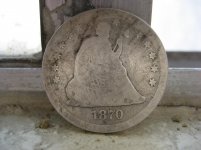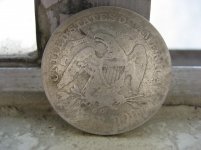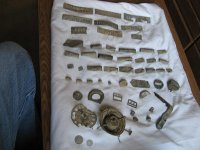Tom_in_CA
Gold Member
- Mar 23, 2007
- 13,804
- 10,336
- 🥇 Banner finds
- 2
- Detector(s) used
- Explorer II, Compass 77b, Tesoro shadow X2
2 buddies and I researched out the spot of a short-lived late 1800's settlement, in the high deserts of southern CA. There's nothing there now except scars on the desert floor some scattered wood, cast iron and square nails lying around, etc.... The perfect "spaghetti western" type site, eh? 
I scored the first coin: an 1877 P seated dime, of little numismatic value. Then my buddy Chris gets a seated quarter. At first we couldn't remember if this was one of the rare CC dates from the '70s or not. Imagine our surprise when we got back to our hotel room to check out the books.
Current PCGS website puts the G-4 grade at $9,500
http://www.pcgs.com/prices/PriceGuideDetail.aspx?MS=1&PR=1&SP=1&c=109&title=Liberty+Seated+Quarter
However, coin books and the "grey sheet", from as recent as this year's publication (which go on data from last fall, perhaps), list it at starting anywhere from $4k to $6.5K for G-4. We realize that the redbook, for instance, is generally the retail price, and the "grey sheet" is the wholesale price (what dealers expect to pay YOU, the guy off the street). But this does not explain the multi-thousand dollar discrepancy with the current PCGS site. A little sleuthing around reveals a possible explanation:
For things this rare, prices can shift suddenly with a single auction. Ie.: Even with 8,340 minted, it's safe to say that no more than a handful could be found for sale, at any time. Ie.: if you went to buy one, good luck on even finding one. Like cars: there may have been XX number of thousand mercedes benz made in 1949, but good luck on finding a whole one for sale now. So with something that potentially changes hands so infrequently, a coin collector friend told me that he surmises the reason for the discrepancy, is that perhaps one has auctioned off recently, and the PCGS website is simply more current than the books or sheets. Any other ideas on the discrepancy?
Also I found that it is only the G-4 grade which has taken this big jump. Ironically, the higher grades of the SAME EXACT coin have taken a drop in value. Check out these two links, and eyeball down to the '70cc quarter line. Notice the lower grade of this coin has been one of the top appreciators in the last 3 yrs. (although it doesn't say WHEN, within that 3 yr. period, it took this jump?)
Top gainers of the last 3 yrs:
http://www.pcgs.com/prices/AllChanges.aspx?period=3 years&direction=gain&category=714
Top loosers of the last 3 yrs:
http://www.pcgs.com/prices/AllChanges.aspx?period=3 years&direction=loss&category=714
Chris has gotten proffessional opinion that his would only grade AG-3 (a bit below "G" grade). Any thoughts on this grade?
Other than the seated quarter and dime, the other items found were typical of western ghost town/settlements: harmonica reeds, bullet shells, lantern parts, powder measure mechanism, rivots, etc.....

I scored the first coin: an 1877 P seated dime, of little numismatic value. Then my buddy Chris gets a seated quarter. At first we couldn't remember if this was one of the rare CC dates from the '70s or not. Imagine our surprise when we got back to our hotel room to check out the books.
Current PCGS website puts the G-4 grade at $9,500
http://www.pcgs.com/prices/PriceGuideDetail.aspx?MS=1&PR=1&SP=1&c=109&title=Liberty+Seated+Quarter
However, coin books and the "grey sheet", from as recent as this year's publication (which go on data from last fall, perhaps), list it at starting anywhere from $4k to $6.5K for G-4. We realize that the redbook, for instance, is generally the retail price, and the "grey sheet" is the wholesale price (what dealers expect to pay YOU, the guy off the street). But this does not explain the multi-thousand dollar discrepancy with the current PCGS site. A little sleuthing around reveals a possible explanation:
For things this rare, prices can shift suddenly with a single auction. Ie.: Even with 8,340 minted, it's safe to say that no more than a handful could be found for sale, at any time. Ie.: if you went to buy one, good luck on even finding one. Like cars: there may have been XX number of thousand mercedes benz made in 1949, but good luck on finding a whole one for sale now. So with something that potentially changes hands so infrequently, a coin collector friend told me that he surmises the reason for the discrepancy, is that perhaps one has auctioned off recently, and the PCGS website is simply more current than the books or sheets. Any other ideas on the discrepancy?
Also I found that it is only the G-4 grade which has taken this big jump. Ironically, the higher grades of the SAME EXACT coin have taken a drop in value. Check out these two links, and eyeball down to the '70cc quarter line. Notice the lower grade of this coin has been one of the top appreciators in the last 3 yrs. (although it doesn't say WHEN, within that 3 yr. period, it took this jump?)
Top gainers of the last 3 yrs:
http://www.pcgs.com/prices/AllChanges.aspx?period=3 years&direction=gain&category=714
Top loosers of the last 3 yrs:
http://www.pcgs.com/prices/AllChanges.aspx?period=3 years&direction=loss&category=714
Chris has gotten proffessional opinion that his would only grade AG-3 (a bit below "G" grade). Any thoughts on this grade?
Other than the seated quarter and dime, the other items found were typical of western ghost town/settlements: harmonica reeds, bullet shells, lantern parts, powder measure mechanism, rivots, etc.....
Attachments
Upvote
0








 Thanx for taking the time to write that out.
Thanx for taking the time to write that out.
 Jeff always seems pretty adament on the details for a banner find. Don't know about a "group find"?
Jeff always seems pretty adament on the details for a banner find. Don't know about a "group find"?  jgas
jgas

